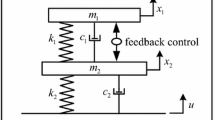Abstract
For an absorber with the magnetic action and the delayed feedback, the equivalent strongly nonlinear model of the magnet force is proposed. We develop an identification algorithm with correcting distorted output measurement to identify and estimate the relevant parameters of the equivalently nonlinear model and the time delay in the feedback loop. The detailed steps of the algorithm are given analytically. We configure an experimental device of a delayed electromechanical absorber with action of the nonlinear magnetic force. The new algorithm is employed to identify the relative parameters of the device, such as time delay, damping and nonlinear stiffness, based on data of the output measurement with distortion. The results show that it is reasonable that the magnet action may be equivalent to the cubic nonlinear force. One may also see that the new algorithm may treat the experimental distorting measurement and correct it as long as the measurement still keeps periodicity. As an important result, values of the identified parameters with the correcting distortion are closer to those of the original measurement than those without the no correcting distortion for some excitation frequencies. It means that the algorithm may correct the polluted measurement, so that the quality of the identification is greatly improved. The new algorithm may be useful for design of nonlinear electromechanical absorber with time-delayed feedback.









Similar content being viewed by others
References
Sun, Y., Xu, J.: Experiments and analysis for a controlled mechanical absorber considering delay effect. J. Sound Vib. 339, 25–37 (2015)
Xu, J., Sun, Y.: Experimental studies on active control of a dynamic system via a time-delayed absorber. Acta Mech. Sin. 31(2), 229–247 (2015)
Zhao, Y.Y., Xu, J.: Effects of delayed feedback control on nonlinear vibration absorber system. J. Sound Vib. 308(1), 212–230 (2007)
Zhao, Y.Y., Xu, J.: Using the delayed feedback control and saturation control to suppress the vibration of the dynamical system. Nonlinear Dyn. 67(1), 735–753 (2012)
Richard, J.P.: Time-delay systems: an overview of some recent advances and open problems. Automatica 39(10), 1667–1694 (2003)
Jo, H., Yabuno, H.: Amplitude reduction of primary resonance of nonlinear oscillator by a dynamic vibration absorber using nonlinear coupling. Nonlinear Dyn. 55(1–2), 67–78 (2009)
Benacchio, S., Malher, A., Boisson, J., Touzé, C.: Design of a magnetic vibration absorber with tunable stiffnesses. Nonlinear Dyn. 85(2), 893–911 (2016)
Insperger, T., Lehotzky, D., Stepan, G.: Regenerative delay, parametric forcing and machine tool chatter: a review. In: IFAC-Papers Online, vol. 48, no. 12, pp. 322–327 (2015)
Hajdu, D., Insperger, T., Stepan, G.: Robust stability analysis of machining operations. Int. J. Adv. Manuf. Technol. 1–10 (2016). doi:10.1007/s00170-016-8715-0
Verduyn Lunel, S.M.: Parameter identifiability of differential delay equations. Int. J. Adapt. Control 15(6), 655–678 (2001)
Belkoura, L., Orlov, Y.: Identifiability analysis of linear delay-differential systems. IMA J. Math. Control I 19(1 and 2), 73–81 (2002)
Orlov, Y., Belkoura, L., Richard, J.P., Dambrine, M.: On identifiability of linear time-delay systems. IEEE T. Autom. Control 47(8), 1319–1324 (2002)
Gomez, O., Orlov, Y., Kolmanovsky, I.V.: On-line identification of SISO linear time-invariant delay systems from output measurements. Automatica 43(12), 2060–2069 (2007)
Orlov, Y., Kolmanovsky, I.V., Gomez, O.: Adaptive identification of linear time-delay systems: from theory toward application to engine transient fuel identification. Int. J. Adapt. Control 23(2), 150–165 (2009)
Björklund, S., Ljung, L.: An improved phase method for time-delay estimation. Automatica 45(10), 2467–2470 (2009)
Liu, T., Gao, F.: A frequency domain step response identification method for continuous-time processes with time delay. J. Process Control 20(7), 800–809 (2010)
Zhang, X., Xu, J.: Time delay identifiability and estimation for the delayed linear system with incomplete measurement. J. Sound Vib. 361, 330–340 (2016)
Xia, X., Moog, C.H.: Identifiability of nonlinear systems with application to HIV/AIDS models. IEEE Trans. Autom. Control 48(2), 330–336 (2003)
Zhang, J., Xia, X., Moog, C.H.: Parameter identifiability of nonlinear systems with time-delay. IEEE Trans. Autom. Control 51(2), 371–375 (2006)
Anguelova, M., Wennberg, B.: State elimination and identifiability of the delay parameter for nonlinear time-delay systems. Automatica 44(5), 1373–1378 (2008)
Loxton, R., Teo, K.L., Rehbock, V.: An optimization approach to state-delay identification. IEEE Trans. Autom. Control 55(9), 2113–2119 (2010)
Chai, Q., Loxton, R., Teo, K.L., Yang, C.: A unified parameter identification method for nonlinear time-delay systems. J. Ind. Manag. Optim. 9(2), 471–486 (2013)
Lin, Q., Loxton, R., Xu, C., Teo, K.L.: Parameter estimation for nonlinear time-delay systems with noisy output measurements. Automatica 60, 48–56 (2015)
Yan, X.G., Spurgeon, S.K., Edwards, C.: State and parameter estimation for nonlinear delay systems using sliding mode techniques. IEEE Trans. Autom. Control 58(4), 1023–1029 (2013)
Ren, X.M., Rad, A.B.: Identification of nonlinear systems with unknown time delay based on time-delay neural networks. IEEE Trans. Neural Netw. 18(5), 1536–1541 (2007)
Wen, Y., Ren, X.: Neural observer-based adaptive compensation control for nonlinear time-varying delays systems with input constraints. Expert Syst. Appl. 39(2), 1944–1955 (2012)
Zhang, X.X., Xu, J.: Identification of time delay in nonlinear systems with delayed feedback control. J. Frankl. Inst. 352(8), 2987–2998 (2015)
Acknowledgements
This research is supported by the National Natural Science Foundation of China under Grant No. 11572224.
Author information
Authors and Affiliations
Corresponding author
Appendix
Appendix
The closed form of \(\mathbf{H}_\mu ^{{\omega } _s } , \mathbf{H}_1^{{\omega } _s } \), and \(\mathbf{H}_2^{{\omega } _s } \) in Eq. (15) are given by
where

and \(\Phi _{2,i}^{{\omega } _s } \) is the element at row i in vector \({\varvec{\Phi }}_2^{{\omega } _s } \).

where
and

where
and \(\Psi _{2,i,j}^{{\omega } _s } \) is the element at row i and column j in matrix \({\varvec{\Psi }}_2^{{\omega } _s } \).
Rights and permissions
About this article
Cite this article
Zhang, X., Xu, J. & Feng, Z. Nonlinear equivalent model and its identification for a delayed absorber with magnetic action using distorted measurement. Nonlinear Dyn 88, 937–954 (2017). https://doi.org/10.1007/s11071-016-3286-z
Received:
Accepted:
Published:
Issue Date:
DOI: https://doi.org/10.1007/s11071-016-3286-z




